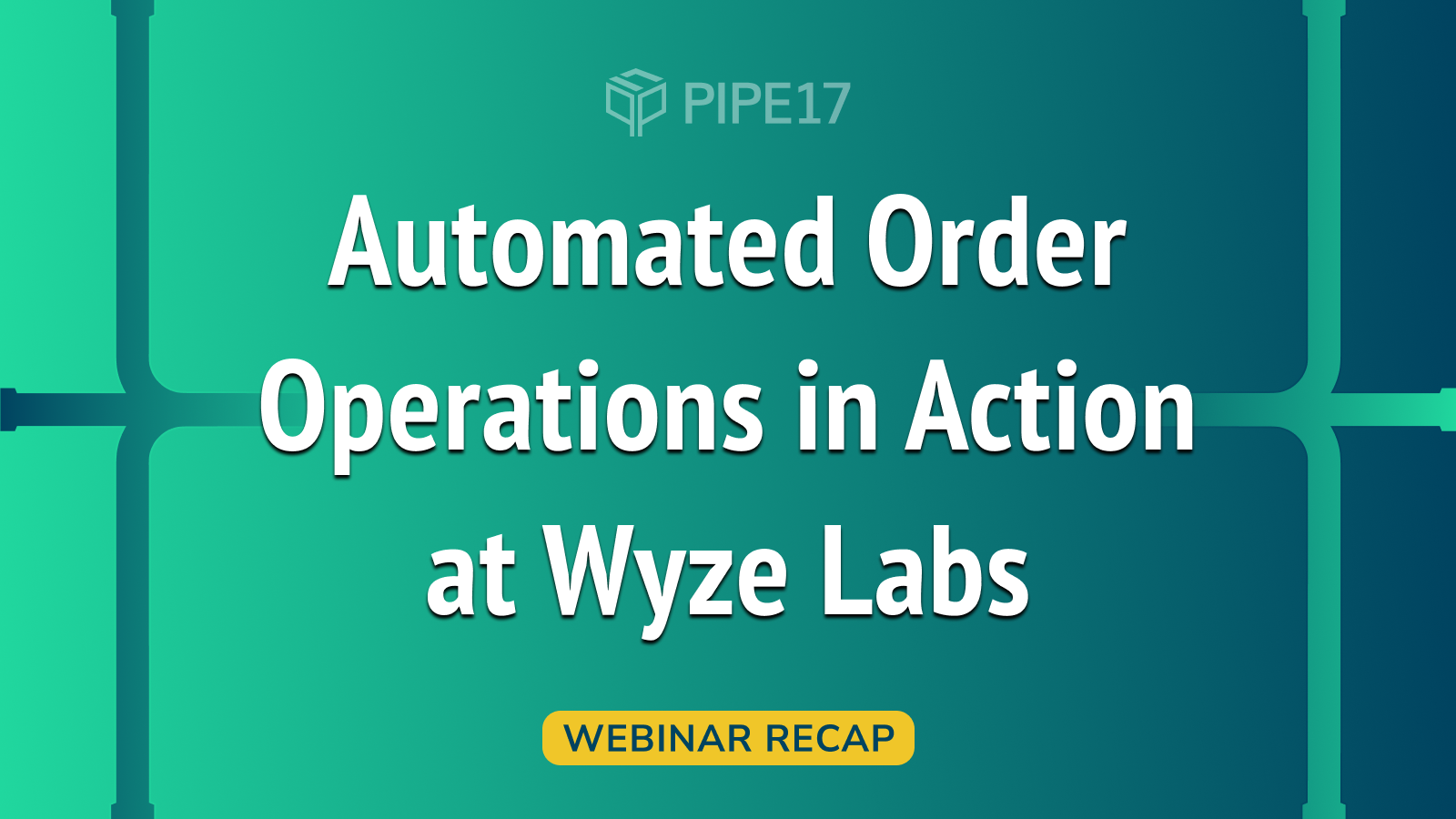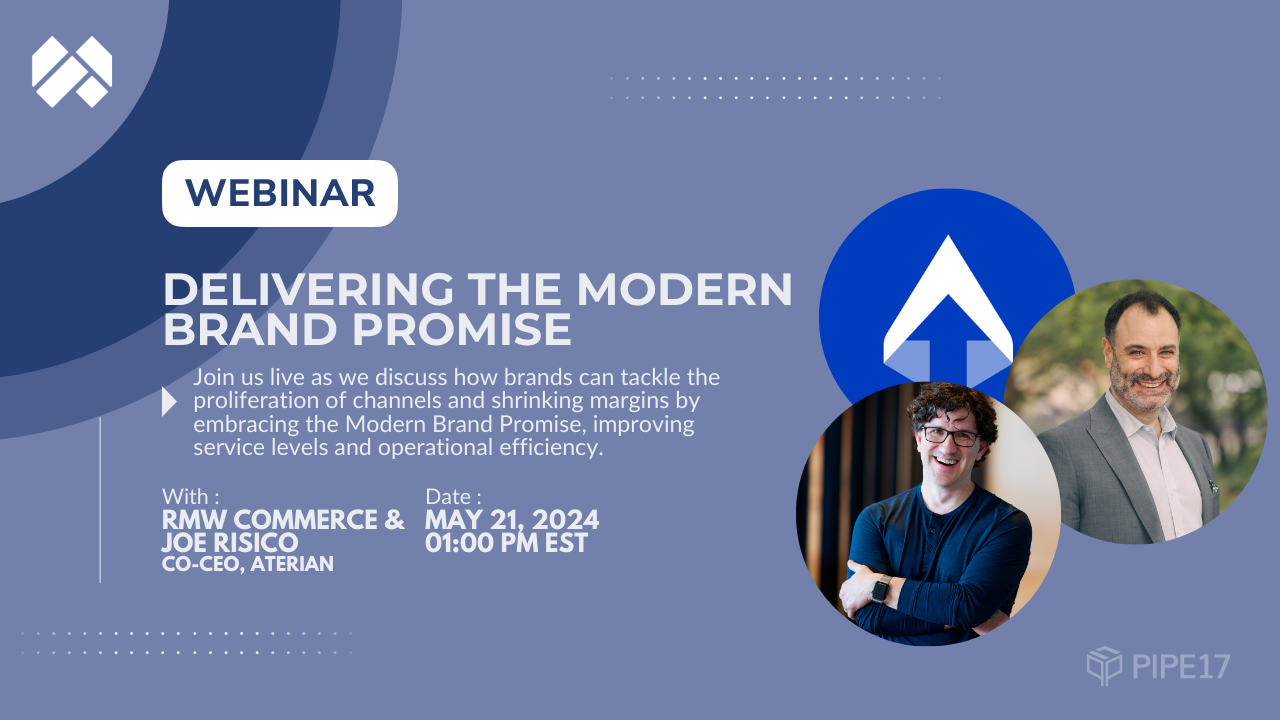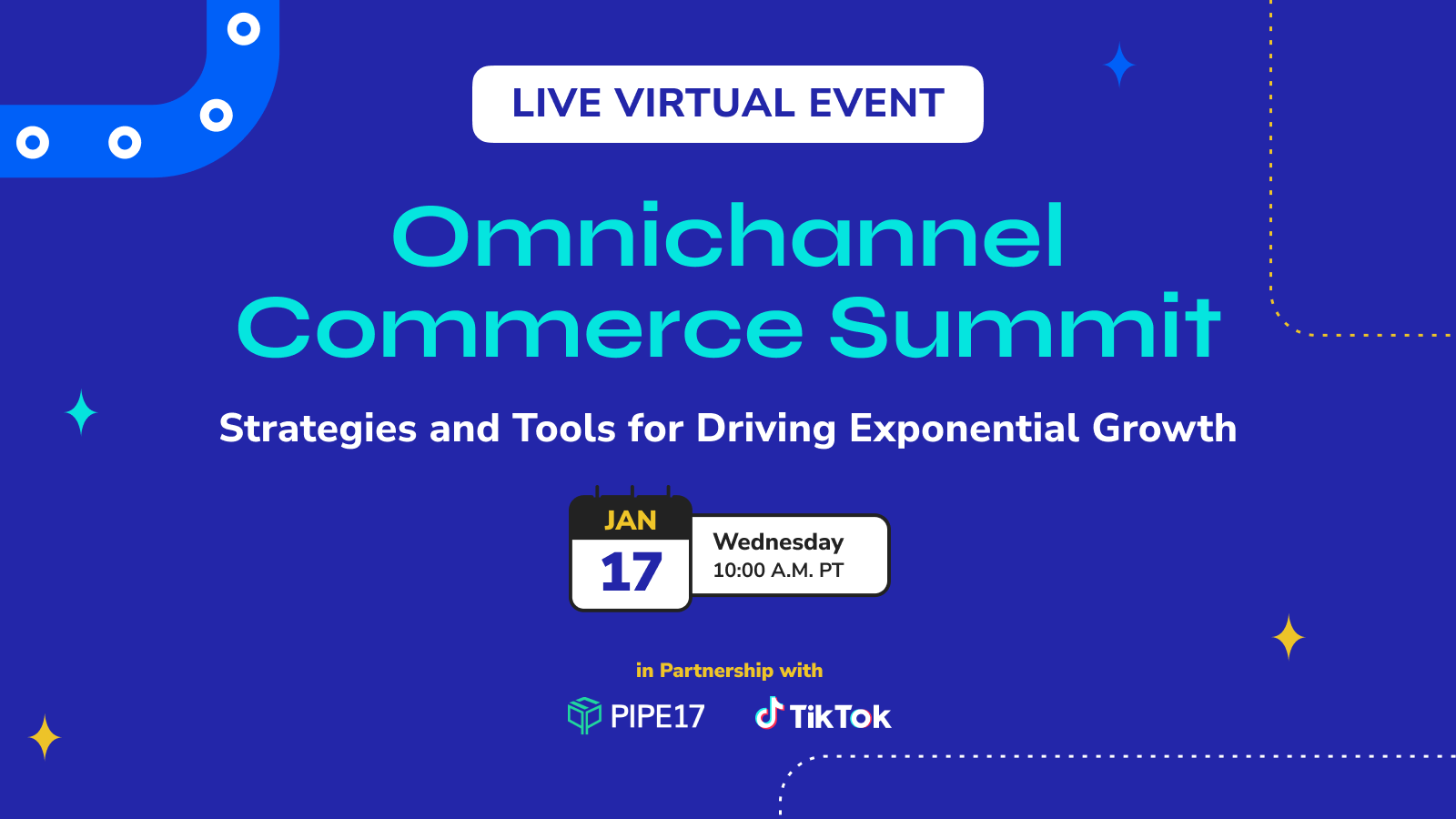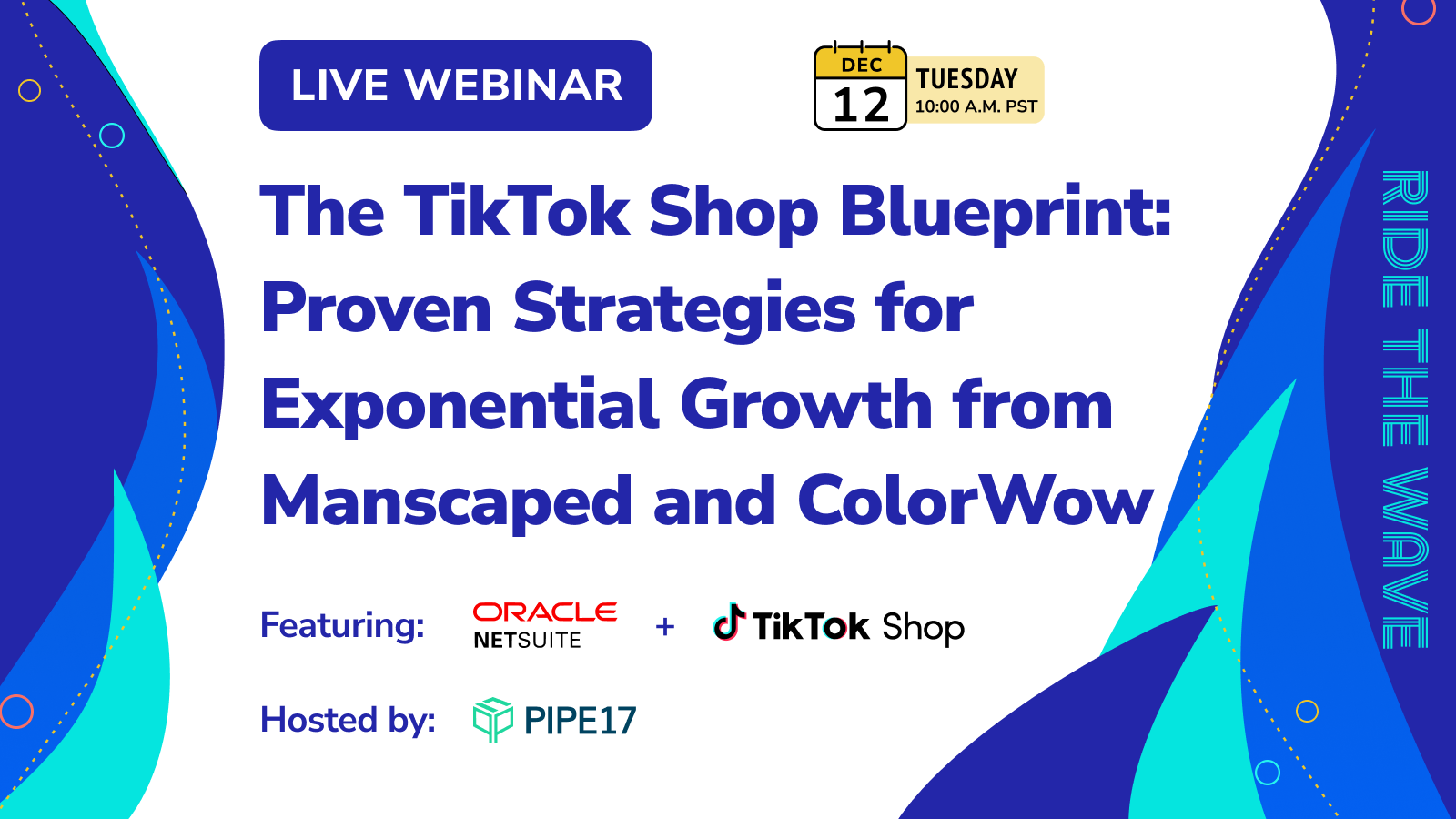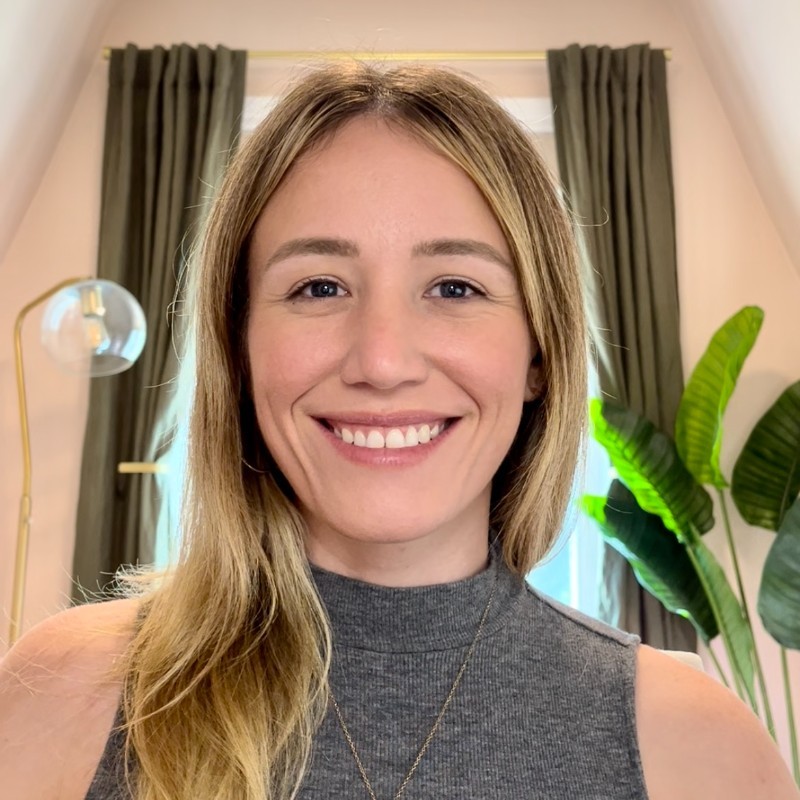Recently, Pipe17’s CEO Mo Afshar hosted a webinar featuring our customer, Wyze Labs. Wyze is a leading manufacturer of wireless cameras and other smart home products. Mo was joined by Logan Dunn from Wyze as well as Rotem Yuz from Amazon for a lively discussion on topics ranging from merchant growth strategy to order operations management.
Watch the full webcast
Read a transcript of the panel discussion
- Speaker Introductions
- Ecommerce Landscape
- Building Wyze
- Growth Drivers
- Order Operations
- Pipe17 Benefits
- Amazon MCF Overview
- Amazon MCF Benefits
- Buy with Prime
- What’s Coming Next
- Summary
- Questions & Answers
Speaker Introductions
DERRIC HAYNIE, Head of Demand Generation, Pipe17:
Hello everyone, and welcome to the webinar: “Automated Order Operations at Wyze Labs”, presented by Pipe17 in partnership with Amazon Multi-Channel Fulfillment and Wyze Labs. I’m Derric Haynie from the Pipe17 team. I’m going to pass it over to Mo to introduce himself and today’s panelists. Mo, take it away.
MO AFSHAR, CEO, Pipe17:
Thank you so much, Derric. Welcome everybody. I’m co-founder of Pipe17. I am so excited to have some great panelists with me today. Logan, tell us who you are and what you do.
LOGAN DUNN, Head of Ecommerce, Wyze Labs:
Hello everyone. I’m Logan Dunn. I am the head of ecommerce, which is head of all D2C channels that we have. I’ve been here at Wyze for about four years, and we’ve been a Pipe17 customer for about a year and a half now.
MO:
Excellent, thank you. Rotem, over to you.
ROTEM YUZ, Head of Technology Partnerships, Amazon Supply Chain
Thank you for having me. My name is Rotem and I lead technology partnerships for Amazon Multi-Channel Fulfillment, also known as MCF. Also, I lead the Buy with Prime agency team. My team is working with order management software, ecommerce channels, ERPs, and different tools and services that merchants use in order to manage their business. We have to build integrations to MCF so they can automate the fulfillment of their orders with Amazon Fulfillment Network. I’ve had the pleasure to work with Pipe17 for about two years. We actually have our anniversary this month! So happy to talk about the Wyze journey with Pipe17 and MCF.
Ecommerce Landscape
MO:
Perfect. Fantastic. So with that, I’m going say a few words about the ecommerce landscape, what we’re seeing, some of the challenges that merchants have, and then quickly move to the panel.
It’s pretty clear that ecommerce is still a thing. We have $5 trillion in sales – a big percentage of retail – 20+% of retail sales. But as we’re seeing, whether you’re a retailer or you’re an emerging brand or you’re an established brand, the same set of challenges prevail, which is: you have the need to grow your business. These days it’s getting a little bit tougher to do that. So you need to do things like B2B and sell through retail continues in order to grow your business.
On the other side, of course, customer expectations are through the roof. You know there was a recent survey that 61% of consumers want their stuff within three hours. We have Rotem and the team at Amazon to thank, along with others. Then of course people need to save money so saving costs is a big factor these days. If you look at these three key factors, they put a lot of pressure on businesses, whether you’re a retailer or a brand or any other ecommerce provider.
As we kind of drill down into that, we see that the predominant problem is really around what Pipe17 calls Order Operations. That is in fact the title of this webinar: Order Operations with Wyze. What your operations is ultimately about is collecting orders from lots of different sources, whether that is your own dotcom, on Shopify or other platforms, on marketplaces like Amazon. In fact, there are many others: retail, wholesale, point of sale, B2B, etc.
Collecting all those orders and then shuttling them down into the right set of places is getting harder and harder to do because there’s big technology changes. For example, with composable, people swap out things like fulfillment providers and return systems all the time. There’s a little bit of vendor churn. It’s really hard to get a consistent view of where your business is, what inventory you have, what you are selling where. That challenge makes it harder and harder as businesses grow, which basically leads to lost opportunity. Selling more across more channels can lead to lost margins. The problem ultimately becomes more and more prevalent as businesses scale.
Hence, we’ve got a great customer of ours to talk through how they’ve dealt with it.
A quick ten second plug for what we do. We have an Order Operations Hub at Pipe17. In one simple sentence: we connect selling channels, online marketplaces, retail, point of sale, etc. to the physical world. Think about it like fulfillment and 3PLs, and then systems of record (ERPs, financials, and many others). Customers of ours include great brands such as Wyze, but also people within the ecosystem: some software providers, some fulfillment providers. Everybody’s got a common goal to make it easy for merchants to run their Order Operations.
Building Wyze
MO:
With that, I’d like to welcome Logan once again. Logan, tell us about Wyze. You’ve built an amazing company and amazing brand. How have you managed to build the brand, the company, and your growth?
LOGAN:
I’ve been at Wyze for about four years. Wyze is only five and a half years old. So I’ve been here since the beginning. We got really lucky by having a disruptive market. That helped us grow just incredibly fast. We introduced the $20 security camera into the market when, at the time, home security cameras were $150-200 apiece. Things really took off. Got a lot of press. We just did our best to keep up with operations, make our products, deliver them on time. During that rapid growth phase, it was mostly about, “Can we make enough cameras?” Then over the last few years… so actually I joined doing product marketing… I would make videos like the one we just saw with the agency teams. Had a lot of fun bringing these products to market.
Then I moved into a position as Head of Growth and worked on helping to grow our service subscription model. We attach a premium subscription to our cameras if people want it. We have a freemium version as well. Then I moved into the D2C space running our D2C P&L with my team a little over a year and a half ago. Man, it’s flying by. So that’s a little bit about us.
Our co-founder Dave Crosby, he’s our CMO. He leads our team. So I sit on a team with my counterpart who runs our retail channels and I run everything direct.
Growth Drivers
MO:
I’m sure the audience is going to be super interested so I’ve got to ask you, what have been the big growth drivers for your business? We obviously work very closely together, so we’ve seen the amazing growth in your business from very early on. I’m sure people would love to hear just a few tips and tricks around how you managed to grow so aggressively.
LOGAN:
We actually started on Amazon. We created a product to compete with just whatever was available on Amazon at the time. The reason we did is because our co-founders are ex-Amazon employees. They left Amazon to do their own company. We started there, but we quickly moved into direct to consumer. We saw the value that direct to consumer is our largest single channel for Wyze.
Early on, when I first got to Wyze, I called up one of my friends and asked him. He was VP of Digital at a retail/ecommerce company. I said, “What are your biggest levers you pull?” Really in ecommerce you have three main levers. You have your traffic, you have your average order value, and then you have your conversion rate.
Then I said, “Well, what do we need to do?” And he was like, “Email! You need to make your email list just powerful. Really, when he said email, he was talking about our direct customer relationships. And that’s something we’ve really valued.
We have a core value of being friends with our users. We just did our Community Appreciation Day yesterday. We have tried to really build a community, maintain a community, market to our community, and that’s served us really well. We’ve actually been able to maintain low customer acquisition costs. Part of it, let’s be honest, was that lightning struck for us. We entered with the innovative product at a needed time. So we got a lot of press coverage. We maintained our press relationships. But really, we do focus very directly on marketing and working with our customers.
MO:
I remember we had cameras from another company, and one of them broke. Going online, the Wyze cameras were like 25 bucks at the time, which was the first one you released. I just could not believe it! I said I’ve got to buy this. And it worked and worked so well.
LOGAN:
Actually, one of our early articles that was published, I think it was an article on The Verge. It might have been in PC Magazine, I can’t remember. But the author said, “These Wyze cameras are too good to be true.” So actually, we incorporated that into our customer experience value. We have a value now to create too-good-to-be-true products. The point is: really make the amount of value you get out of a product far exceed the price. So it seems almost too good to be true.
Order Operations
MO:
Amazing. Let’s move to operations. We talked about the growth. We talked about how you built your business. How have you managed your operations as you’ve grown your business?
LOGAN:
That’s a great question. We started with our own… we did have a 3PL. We’ve never really done our own warehousing. We had a local 3PL and, as we grew, we quickly grew out of that. We weren’t able to stand that. We actually went over and did a partnership with FedEx. We did FedEx third party logistics. They did the packaging, shipping, all of that stuff. We even started with WooCommerce, the commerce platform built on top of WordPress. We transitioned quickly, after like one year, into Magento. We were on Magento for a while and built our own custom connectors into our local 3PL. We used Order Desk to connect Magenta into FedEx. And that’s kind of where we were.
We had a lot of black boxes, to be honest, a lot of stuff we couldn’t see and didn’t know were problems. I mean, we’d hear customer complaints. I think the general service rule of thumb is for every complaint you hear, there’s 25 other people with that same complaint. So if you get 100 of the same complaint, you’ve got 2,500 different people with that same problem.
We sought to improve our operations from the beginning. We have a team, the Lift Team, that’s our operations team. Lift, like they “lift the company up”. Their own internal company logo is the bicep emoji, and they focus on that. Really strong operations like that are what buoys your company up.
That’s seen at Amazon. We brought a lot of the founding values of Amazon to our company since our founders came from there. Like the idea of the flywheel as how do you get your efficiencies. Amazon is the same way. They started with a strong operational foundation, and then they moved into how to dominate the commerce space.
We saw quickly with these black boxes that we needed to upgrade and change our commerce stack. I came in and we did a revamp. We switched over to Shopify Plus. We quickly saw that our current connectors, like literally within a month on Shopify Plus, we hadn’t even fully transitioned over, we started into panic mode. We were like, “Oh my gosh, these connectors! We’re not getting what we need.”
We switched. We did our research right away. We went over to Pipe17 very quickly after that migration. That just solved a ton of our problems. We moved. We migrated to Amazon MCF from FedEx at about the same time. A lot of that was due to our order SLAs to our customers that were longer than we wanted. We were looking to enhance our customer experience, right? Really be friends with our customers. Trying to get everything to work together was definitely complex. That was, and that’s been, our big task. We’ve done a total replacement of our commerce tech stack over the last 12 months.
MO:
Wow. We’ve seen the pace at which you guys have been iterating.
LOGAN:
You guys get to see exactly what we connect to. We connect everything to you guys!
Pipe17 Benefits
MO:
Exactly. We get to see all of it.
As you look at it, what have been some of the greatest benefits from a business perspective of you partnering with Pipe17?
LOGAN:
We’re still seeing some of the big benefits, right? We’re actually bringing on a new 3PL provider, kind of a backup that we’re working on. We are probably 90-95% Amazon MCF now. But the ability to bring on a small partner to help ship certain products is really easy. We’re hoping to be up to speed in under three weeks, probably four to five weeks, if we include ship-in times to put some of our products over in that 3PL. We have a fairly large operation. We’ll do over a million orders this year. So anything, we have to automate it. It’s kind of like automate or die! That was one of the main reasons we went over.
I have a team member, Eric Morris. He’s phenomenal. He’s a principal technical lead. He’s the guy you primarily work with, right? He’s the one who actually researched different order management systems and finally settled on Pipe17. I know you brand yourself as much more than order management, of course. But the order management aspect of your platform seemed to meet our needs. Eric was like, “We’ve gotta do this. We need to automate. We have to get rid of these inefficiencies.”
To be honest, we were able to cut our operations overhead in half just by reducing the need for headcount. We were able to implement quicker. The biggest thing, I think, was uncovering the black boxes. Seeing, “Oh my gosh, what? This is happening?” We went from an average of seven days click-to-delivery, with many between the 7-14 day range. With Amazon MCF and Pipe17, now that we have it all connected, our latest quarterly business review was 3.3 days click-to-delivery. That’s standard ground. Obviously, it’s faster if they choose a faster option. But standard ground of 3.3 days; that’s pretty amazing.
Amazon MCF Overview
MO:
That’s amazing. Good. Thank you, Logan. I’m going to segue way to Rotem here.
You mentioned Amazon MCF a few times. Look, I hadn’t heard of MCF when we got to know what it was about, and many customers haven’t. Obviously, it’s been a critical part of your business and your operations. So with that, I want to bring Rotem in. Rotem, what is it?
ROTEM:
Logan, it’s so nice to hear your success story with MCF.
Yeah, I’ll give an overview of what it is. In many ways, we give merchants the power to use Amazon Fulfillment Network in the business outside of Amazon. Amazon Multi-Channel fulfillment is a 3PL that enables merchants to use our fast and reliable shipping speed on their websites and other sales channels where they’re selling social commerce. We basically open the door for a very scalable and well-oiled machine that now they can use to delight their shoppers.
We know that fast and reliable shipping is key to the shopper’s experience, whether you make a decision to buy something or not. You see it especially around holidays or special events, but also with specific products. If I run out of dog food and I know that I need it in two days, and I see a promise date on the website that says that I will get it in two days, it will help me make a decision to purchase. Otherwise, I might go elsewhere to look it up.
Basically, companies like Wyze can connect to us with companies like Pipe17 and start to route orders to our fulfillment centers. We know that about 70% of Amazon sellers are selling on at least one additional sales channel, if not more. If they are the website and different marketplaces and social commerce, they connect all their sales channels to a connector like Pipe17.
So Pipe17 sits nicely between these sales channels and Amazon Multi-Channel Fulfillment. We pick, pack, ship, and deliver the items all the way to the shopper, provide tracking numbers that go to Pipe17 if you do order management there, and all the way to the original point of sale. For example, if it’s Shopify Plus, we will shoot back a tracking number to Shopify so everyone knows that it was fulfilled.
MCF as a 3PL is behind the scenes, meaning you own the merchant experience with the shopper, the relationship with them. You charge them. We are not involved in the way you manage your business.
Another cool feature that we launched is unbranded packaging and opt out for Amazon tracking numbers. So when a shopper, for example, buys an item on a website, he doesn’t expect to get an Amazon box in his mail. We will ship it in unbranded packaging without the Amazon logo, without inserts or anything like that. If the merchant is selling in a sales channel that doesn’t know how to handle Amazon tracking numbers, they can also opt out of this. In this case we’ll provide a tracking number which is a bit more generic.
An interesting fact is that we meet the promise date that we say to ship to shoppers at least 97% of the time. And we fulfill orders seven days a week, which is a huge advantage.
Amazon MCF Benefits
LOGAN:
Yes, that’s huge for us actually, to bring in the weekends. That was a big reason how, or a big way how we got the click-to-delivery down.
ROTEM:
Yeah, it’s also made the expectations that shoppers have, especially if they used to buy on Amazon, to get the promise date, to know that they will get it on time. I’ll even touch a bit more about why it makes sense for a company like Wyze.
Wyze, for example, started selling on Amazon.com and they used the FBA (“Fulfilled by Amazon”) to fulfill their orders. Meaning in this case we already had their inventory. Now, Wyze wanted to establish their D2C business or selling on other channels, testing social commerce. Instead of going and looking for another 3PL or another warehouse, keeping another set of inventory which costs a lot of money, doing their boxes on their own, or negotiating right with the carrier on their own… They told Amazon, “You do what you do best. We’ll do what we do best.”
So you’ll deal with all our pick, pack, and ship services. In that way you can keep 1P inventory, and really reduce costs here.
By working with MCF, Wyze first of all maintains balanced inventory levels. Instead of investing too much working capital on inventory, instead of putting it on ads and growth, they were able to reduce out-of-stock rate. In general, we see that when you use FBA and MCF – basically when you use Amazon Fulfillment Network – with 1P inventory to serve all your sales channels, you can reduce out-of-stock rate by about 13%, which is meaningful because it’s increasing your revenue at the end of the day. As Logan mentioned, they were able to improve click-to-delivery by over 50%, that is more than half. This is something that also helps you to get return shoppers, best reviews, etc. These are some of the highlights that we see.
Buy with Prime
MO:
Excellent. I know I’ve talked to Logan about this as well. Logan, you guys use something called Buy with Prime, right?
LOGAN:
Yeah, which is available to any merchants who are either on MCF or Amazon’s third-party seller program. So it’s not, it doesn’t sync with the first party seller, like if you sell direct on Amazon, but it does work with Seller Central or MCF. We do it.
One really unique thing that we do as well with Buy with Prime and MCF is we have a lot of products that aren’t on Amazon that we distribute through here. We do our spare parts now through MCF. It’s enabled us to open a spare parts store which helps reduce customer service costs. They can get spare parts right away.
We do these now with Buy with Prime, which allows prime customers. It’s basically a button that’s like a checkout button on your site, where if the items are in the Amazon warehouses, Amazon can show an estimated delivery date. That’s usually two days because it actually does use expedited shipping. It is only for Prime customers, at this point at least. When they check out, they get all the benefits of Prime. They get the Prime Promise, prime fast shipping, all of that stuff.
And Amazon with Buy with Prime, they cover your customer support and return costs. I mean, the units are the units, right? The unit gets returned, you get the unit, but they cover the related customer support costs and return shipping costs as well. Of course there’s a small fee associated with that, but we’ve seen a lot of success with that program. We did an A/B test on that, saw about a 25% conversion rate increase, and moved even more inventory out of MCF. So it’s been good.
MO:
…and they all connect by Pipe17!
What’s Coming Next
LOGAN:
Actually, I did just want to… really quick… I know we’re getting short on time here, Mo. But we’re doing some really cool things with Pipe17 right now as well. I think if I were an attendee of this webinar, I’d be like, “Okay, tell me a little bit more what you’re trying to do!”
So we do connect to Shopify, which is our primary order platform that our app is connected to, to the Shopify platform. That goes from Pipe17 to MCF. But we are doing a couple other cool things we’ve been able to work out. We connected our TikTok shop, which is the ability to buy from TikTok. We’re working on connecting that direct into Pipe17 right now and circumventing Shopify, so that we’re not going from one system to the next system, hopping.
To what Rotem said, if we run out of our Amazon 1P inventory on an ASIN (i.e. Amazon Standard Identification Number), we’re connecting the Fulfillment By Merchant channel which allows us then to basically sell as a merchant on listings to help cover inventory gaps. Because 1P, Amazon owns; 3P, we own.
We’re looking at potentially partnering with drop-ship vendors. We actually have done some quick partnerships with drop-ship vendors. But we’re looking at creating integrations that allow us to ship MCF inventory from drop-ship portals, which is super appealing to drop-ship vendors because they’re like, “How fast can you get it to me, or to the customers?”
Those are some of the things that I think are cool that we’re doing that enable our D2C to spread a little bit more that we might not do if we had to take extra effort to manage APIs, maintain their integrity, and make sure everything’s going.
Then the other really cool thing that we’re doing is we’re using the Snowflake connector with Pipe17 to bring all of our Pipe17 data into Snowflake. We’ve built our own dashboards. This is our dashboard created in Snowflake. This is straight Pipe17 data. What we have in here, we have how many days old are shipments. This helps us quickly see those black boxes I mentioned. We can quickly see the black boxes, like what gets held in exception, what’s going too long. Down at the bottom left, we do it by SKU so we can see which SKUs might be an exception, which helps us also find out-of-stocks faster. We get to monitor and watch delivery speeds. We keep an eye on those.
We also pull the same data into a Tableau report. This is an operational efficiency report that we do. And this again, it’s all Pipe17 data, but we pull in like our weeks of coverage, we look at split shipments, we look at split shipments among carriers, across 3PLs. And so we’ve been able to reduce costs by just tackling problems as they come in. We use, like I said, Pipe17 data in our own warehouse.
MO:
Yeah, that’s fantastic, Logan.
One of the big things about data warehousing projects in general is: how do you get access to the data? How do you set up the schema? Then how do you run reports off it? Of course the great thing about the Pipe17 connectors that we have for Snowflake, Amazon S3, Redshift and others, is that it enables you guys to just turn it on, get the data in there, and then run your reports. So instead of taking three to six months to do it, you could do it in a week.
LOGAN:
I will say that Snowflake was a nice surprise because we didn’t… We bought you for order management, right? But this is where you do more. It also allows us from an accounting standpoint to connect to our system of record (we use NetSuite), so that we can book sales on ship dates rather than on order. Again, it helps us just be a little more efficient and not maintain connectors to get our D2C data into our ERP.
Summary
MO:
Fantastic. That is great. So just to summarize, I think these are some of the things that you shared with us, Logan. If you want to say a few words on this, but generally reduction in click-to-deliver speed, clearly it was probably more significant than 50%. And of course, reduction in fulfillment costs, and quick! You want to add any color?
LOGAN:
No, I mean it kind of says it all. 50% is not even… that’s like a conservative estimate because we were going averages to averages. I would say like 90% of our customers are like two-day. We now get customers one-day just normal ground speed, if you’re in major metropolitan areas. So overall customer experience, we get a lot of customer comments too. They notice it, right?
MO:
Yes, precisely.
LOGAN:
It’s been pretty great.
MO:
Fantastic. All of it is enabled by the Order Operations Hub from Pipe17. We’re all for automation, efficiency, and getting your operations in sync across your different systems, whether it’s financials, ERP, selling channels, fulfillment, etc.
I want to offer huge thanks to both of you. Logan, thank you so much for helping us with the webinar today and really sharing your story – because this has ultimately been about you, the amazing company and brand that you guys have built, and a lot of great anecdotes for people who’ve attended.
And thank you so much to Rotem for really providing the context around how you partner with Wyze in particular and help them scale their business. Thank you, panel. Thanks everyone.
DERRIC:
If you are interested in learning more about Pipe17 and talking with an integrations consultant to connect your ERP, 3PLs, and selling channels, you can simply visit pipe17.com/contact-us to get in touch with the team.
Questions & Answers
Make sure to watch the full webinar to see how Logan, Rotem and Mo answer questions like these:
- What was the most efficient, yet compliant way, you move customers off Amazon to your own marketing site?
- Why did you move off WooCommerce?
- What were your hesitations with using Amazon MCF, and what have you learned from your experience that you didn’t know at the start?
- What’s your philosophy on shipping costs, do you share any information about shipping costs with your customers?


